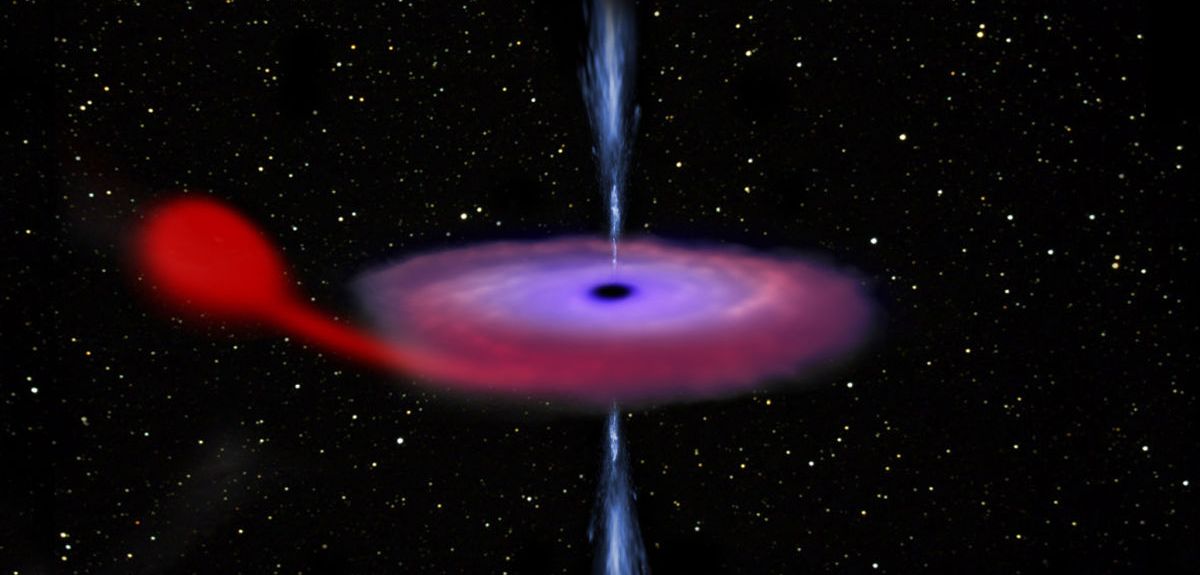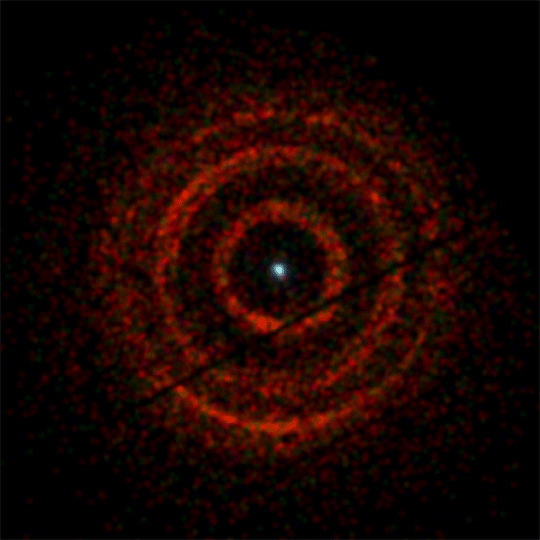
Image credit: ESA/ATG medialab
Black hole awakes after 26 years
On 15 June 2015, V404 Cygni (V404 Cyg), a binary system comprising a sun-like star orbiting a black hole, woke up. A huge outburst of energy across the electromagnetic spectrum ‘lit up’ the sky. The last such outburst was 1989.
Dr Kunal Mooley, a Hintze Research Fellow at the University’s Centre for Astrophysical Surveys works on cutting-edge research based on the discovery and detailed study of transients at radio and optical wavelengths using a wide range of telescope facilities such as the Jansky Very Large Array, the Arcminute Microkelvin Imager (AMI), the Palomar Transient Factory, and the Giant Meterwave Radio Telescope. His research has revealed new physics operating in powerful galaxies called "active galactic nuclei" and has also uncovered intriguing extragalactic explosive events such as supernovae and gamma-ray bursts illuminating the dynamic radio sky. Recently, he carried out an intensive observing campaign with the AMI telescope at Cambridge to monitor V404 Cyg. This work, carried out in close collaboration with Professor Robert Fender of the Oxford Astrophysics sub-department, has helped paint a stunning picture how black holes can launch relativistic jets.
V404 Cyg was known to astronomers in the 18th century as a variable star in the constellation of Cygnus. Until the late 20th century, astronomers considered it to be a nova, a binary star system consisting of a white dwarf and a sun-like star undergoing sporadic outbursts. V404 Cyg first came into spotlight in 1989, when it underwent an outburst, releasing enormous energy over a span of a few months, and especially at X-ray, optical and radio wavelengths.
Not long after the outburst, it was recognised as a new class of X-ray transient sources, called low mass X-ray binaries (LMXBs). This class of transients contain a black hole devouring matter from its companion star, which is usually a sun-like main-sequence star. Through the 1989 outburst of V404 Cyg, astronomers learned a great deal about the accretion and jet-launching mechanisms in Galactic black holes. Once V404 Cyg returned to a quiescent state in the following year, astronomers were able to make accurate measurements of the motion of the companion star and calculate the masses of the two stars of the LMXB. The compact star was found to be twelve times more massive than the Sun, confirming that V404 Cyg contains a black hole. The companion star was about half as massive as the Sun.
During the 1990s, astronomers also reviewed archive data on V404 Cyg from optical telescopes, re-discovering two previous outbursts, in 1938 and 1956. So it appears that V404 Cyg undergoes outbursts every two to three decades. This likely results from material from the companion star piling up in a disc surrounding the black hole until a saturation point is reached. At this point the material is fed to the black hole rapidly, giving rise to an outburst.
Thanks to the Very Long Baseline Interferometric (VLBI) measurements of James Miller-Jones and coworkers, carried out in 2009, the distance of V404 Cyg from the earth is now precisely known to be 2.39 kiloparsecs (7800 light years or around 45.8 quadrillion miles).
 On 15 June 2015 at 7:30PM BST, the Swift space telescope detected a burst of X-ray emission from V404 Cyg and sent out a worldwide alert via the Gamma-ray Coordination Network (GCN).
On 15 June 2015 at 7:30PM BST, the Swift space telescope detected a burst of X-ray emission from V404 Cyg and sent out a worldwide alert via the Gamma-ray Coordination Network (GCN).
The Arcminute Microkelvin Imager Large-Array (AMI-LA) telescope responded robotically to this trigger and obtained sensitive radio observations two hours after the trigger, once the source had risen in the sky.
This early radio observation, carried out at a frequency of 16 GHz, revealed a bright and already-declining radio flare. Early next morning we obtained another observation and found that V404 Cyg was still 200 times brighter than in quiescence. Following this initial detection, we launched an intense observing campaign with AMI-LA, and also triggered the eMERLIN array to get high resolution observations at 5 GHz. The radio observations carried out during the first few days of the outburst revealed several flares with increasing peak brightness and also characteristic oscillations in the intensity of radio emission on timescales as short as 1 hour. These oscillations are similar to those seen in previous LMXB outbursts, and are thought to be due to repeated ejection of matter from, and refilling of, the inner accretion disc.
The V404 Cyg outburst soon triggered a worldwide community of astronomers and amateur observers to perform coordinated observations across the electromagnetic spectrum, from the radio to gamma-ray wavelengths. During the outburst, V404 Cyg was exceptionally bright at optical wavelengths and, we could see it with a 14-inch telescope from the centre of Oxford! So I teamed up with Fraser Clarke, a Systems Engineer in the Astrophysics sub-department, to observe the source with the 14-inch Philip Wetton telescope on the roof of the Denys Wilkinson Building. We obtained measurements simultaneous with the AMI-LA observations to understand the correlation of flares at these two distinct wavelengths. Some flares appeared to be correlated, giving clues about the optical emission mechanism of the outburst. On some occasions, the emission at optical wavelengths arises from the base of a jet launched by the black hole, which expels the accreted matter in the form of a collimated outflow – an outflow in a specific direction. At these times, the radio emission arises from further down the jet, and the time lags between the flares seen at these two different wavelengths gives us the distance of the radio emitting region from the black hole, estimated to be a few thousand light seconds.
V404 Cyg was exceptionally bright at optical wavelengths and, we could see it with a 14-inch telescope from the centre of Oxford!
With the AMI-LA and the eMERLIN telescopes, we have the earliest and widest coverage of V404 Cyg's 2015 outburst at radio wavelengths, which lasted for 30 days. A large number of radio flares were seen, likely associated with relativistic ejections of the accreted matter.
VLBI observations during the outburst carried out by James Miller-Jones, a professor at the Curtin University in Perth, have indeed revealed blobs of plasma ejected by V404 Cyg and moving at speeds close to that of light. We would expect the direction of motion of the blobs to be aligned with the spin axis of the black hole, but we also have hints of blobs moving at two different angles from the VLBI observations. This could be attributed to the precession of the black hole spin, just like a spinning top precesses when set into motion. On 27th June, the biggest radio flare was seen in V404 Cyg, making it one of the brightest sources in the 16 GHz sky for a few hours. After this flare, V404 Cyg started its descent into quiescence.
With the outburst over, our research group at Oxford has turned its focus from radio observations and data processing, to compiling multiwavelength data, analysing and interpreting all the data together, and modelling the flares in order to extract the interesting physics of the V404 Cyg's outburst.
Erik Kuulkers, the project scientist for the INTEGRAL Gamma Ray observatory at the European Space Agency, aptly refers to the 2015 outburst of V404 Cyg as 'a once in a professional lifetime opportunity'. With the outburst over, our research group at Oxford has turned its focus from radio observations and data processing, to compiling multiwavelength data, analysing and interpreting all the data together, and modelling the flares in order to extract the interesting physics of the V404 Cyg's outburst. With the unique data set at hand, we aim at deriving the kinetic calorimetry - the energetics of the outburst, and, for the first time, directly compare the jets launched by black holes residing in own Galaxy with those launched by supermassive black holes residing at the hearts of powerful galaxies called active galactic nuclei (AGN).
About the Arcminute Microkelvin Imager Large-Array (AMI-LA) and the ALARRM observing mode
The AMI-LA is an array of eight 12-metre telescopes located at the Mullard Radio Astronomy Observatory (MRAO) in Cambridge. It observes between frequencies of 14 and 18 GHz. Since 2013, the AMI-LA Rapid Response Mode (ALARRM) has been running where the array is robotically overriden on the basis of Swift triggers. For a suitably positioned source in the sky the array can start observing the target within minutes, delivering a 2 hour observation centred at 16 GHz. This programme has been extremely successful and, to date, more than 150 events have been followed up robotically, delivering exciting science. The ALARRM mode initially began as part of the 4 Pi Sky project whose Principal Investigator is Robert Fender from the Astrophysics sub-department at the University of Oxford.